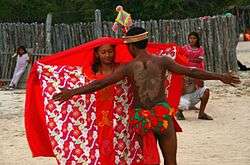Indigenous peoples of South America
The indigenous peoples of South America are the Pre-Columbian peoples of South America and their descendants. These peoples contrast with South Americans of European ancestry and those of African descent.
| Total population | |
|---|---|
| Approximately 32 million | |
| 14.1 million (2017)[1] | |
| 7.02 million (2016 est.)[2] | |
| 4.5 million (2016 est.)[3] | |
| 2.0 million (2012)[4] | |
| 1.8 million (2005)[5] | |
| 1.00 million (2016 est.)[6] | |
| 997,963 (2010)[7] | |
| 524,000[8] | |
| 455,035[9] | |
| c. 60,000[10] | |
| c. 19,000[11] | |
| c. 12,000–24,000 | |
| Languages | |
| Indigenous languages of the Americas, English, Spanish, Portuguese, French, Dutch | |
| Religion | |


In Spanish, indigenous people are often referred to as indígenas or pueblos indígenas (lit. indigenous peoples). They may also be called pueblos nativos or nativos (lit. native peoples). The term aborigen (lit. aborigine) is used in Argentina, and pueblos aborígenes (lit. aboriginal peoples) is commonly used in Colombia. The English term "Amerindian" (short for "Indians of the Americas") is often used in the Guianas. Latin Americans of mixed European and indigenous descent are usually referred to as mestizos (Spanish) and mesticos (Portuguese).
It is believed that the first human populations of South America either arrived from Asia into North America via the Bering Land Bridge, and migrated southwards or alternatively from Polynesia across the Pacific.[12][13][14] The earliest generally accepted archaeological evidence for human habitation in South America dates to 14,000 years ago, the Monte Verde site in Southern Chile.[15] The descendants of these first inhabitants would become the indigenous populations of South America.
Before the Spanish colonization of the Americas, many of the indigenous peoples of South America were hunter-gatherers, and indeed many still are, especially in the Amazonian area. Others, especially the Andean cultures, practised sophisticated agriculture, utilized advanced irrigation and kept domesticated livestock, such as llamas and alpacas.[16][17][18] In the period after the initial arrival of Europeans in 1492 the indigenous population of South America fell rapidly due to a variety of factors, such as disease and warfare (i.e. genocide).[19]
In the present day, there are two South American countries where indigenous peoples constitute the largest ethnic group. These are Peru, where 45% are indigenous, and Bolivia, where 62% of people identify as feeling a part of some indigenous group.[20][21]
South American indigenous peoples include:
- Indigenous peoples in Argentina
- Indigenous peoples in Bolivia
- Indigenous peoples in Brazil
- Indigenous peoples in Chile
- Indigenous peoples in Colombia
- Indigenous peoples in Ecuador
- Indigenous peoples in French Guiana
- Indigenous peoples in Guyana
- Indigenous peoples in Paraguay
- Indigenous peoples in Peru
- Indigenous peoples in Suriname
- Indigenous peoples in Uruguay
- Indigenous peoples in Venezuela
See also
References
- "Perú: Perfil Sociodemográfico" (PDF). Retrieved 22 September 2018.
- "CIA – The World Factbook". Cia.gov. Retrieved 23 February 2011.
- "South America :: Ecuador — The World Factbook". www.cia.gov. Central Intelligence Agency.
- "Censo 2012 - Síntesis de Resultados" (PDF). estudios.anda.cl (in Spanish). Archived from the original (PDF) on 2018-06-21.
- DANE 2005 National Census
- "South America :: Argentina — The World Factbook". www.cia.gov. Central Intelligence Agency (CIA).
- "2010 Census graphics of Brazil government". IBGE(Brazilian Institute of Geograph and Statistic. 2015-02-09.
- "About this Collection" (PDF). The Library of Congress. Retrieved 29 July 2015.
- "8 LIZCANO" (PDF). Archived from the original (PDF) on 20 September 2008. Retrieved 2014-05-22.
- Colchester, Marcus; Rose, Jean La; James, Kid (2002). La minería y los amerindios en Guyana [Mining and Amerindians in Guyana] (PDF) (in Spanish). North-South Institute. ISBN 978-1-896770-44-4. Archived from the original (PDF) on 2010-12-08.
- "Indigene: Guayana Francesa". Indigene (in Spanish). Archived from the original on Aug 20, 2011.
- "Study confirms Bering land bridge flooded later than previously believed". cyberwest.com. Retrieved 2017-02-22.
- Gongora, J.; et al. (Jul 28, 2008). "Indo-European and Asian origins for Chilean and Pacific chickens revealed by mtDNA". Proceedings of the National Academy of Sciences. 105 (30): 10308–10313. doi:10.1073/pnas.0801991105. ISSN 0027-8424. PMC 2492461. PMID 18663216.
- "Journal of the Polynesian Society: Notes And Queries, P 255-258". www.jps.auckland.ac.nz.
- Hey, Jody (2005-05-24). "On the Number of New World Founders: A Population Genetic Portrait of the Peopling of the Americas". PLOS Biology. 3 (6): e193. doi:10.1371/journal.pbio.0030193. ISSN 1545-7885. PMC 1131883. PMID 15898833.
- Earls, John. "The Character of Inca and Andean Agriculture" (PDF). Archived from the original (PDF) on 17 May 2017. Retrieved 22 February 2017.
- "4.1 Raised beds and waru waru cultivation". www.oas.org. Retrieved 2017-02-22.
- Pinedo, Javier Blossiers. "AGRICULTURA DE LADERAS A TRAVÉS DE ANDENES, PERÚ" (PDF). Archived from the original on 14 December 2010. Retrieved 22 February 2017.CS1 maint: BOT: original-url status unknown (link)
- "Massive Population Drop Found for Native Americans, DNA Shows". 2011-12-05. Retrieved 2017-02-24.
- "The World Factbook — Central Intelligence Agency". www.cia.gov. Retrieved 2017-02-24.
- "The World Factbook — Central Intelligence Agency". www.cia.gov. Retrieved 2017-02-24.
External links
| Wikimedia Commons has media related to Indigenous peoples of South America. |
.svg.png)